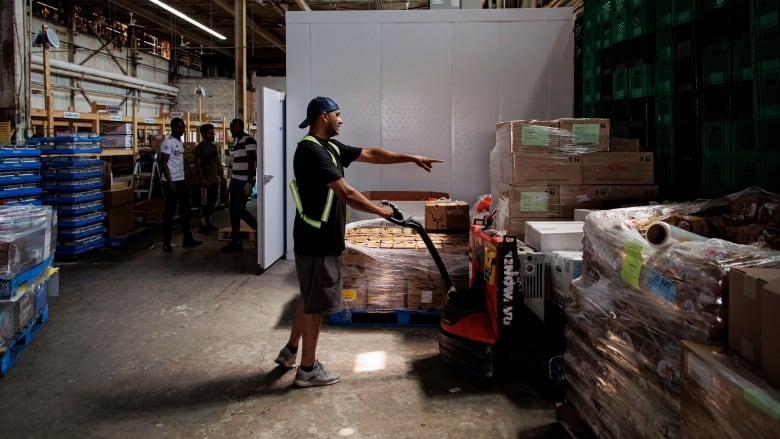As cost of living soars, millions of Canadians are turning to food banks
Every Friday, people line up around the block to pick up dinner from a tiny church off College Street in downtown Toronto. Volunteers working for the food program inside serve a hot casserole, some rice, and maybe fruit and yogurt if supplies come through.
Rev. Canon Maggie Helwig, who helps run the program out of St. Stephen-in-the-Fields church, said it regularly serves 130 people for dinner on Fridays — compared to the two dozen they saw a few years ago.
On Saturday and Sunday mornings, the lineup for breakfast is even longer — with hundreds of parents, seniors, students, working adults and those who are unemployed.
“Every week we are scrambling,” Helwig said. “Every week we run out of food and start foraging in the cupboards and in the freezers for something that we can give to people.
“It’s terrifying.”
That staggering demand is also playing out at food banks and other food programs across the country. A new report from Food Banks Canada released Wednesday found that this year, with the cost of living skyrocketing, food bank usage rose to its highest level since the survey started in 1989.

The annual HungerCount report is based on surveys sent to food security organizations, tracking their usage in the month of March. This year’s report found that nearly two million people — including more employed people than ever — used food banks March 2023 alone.
That’s a 32 per cent increase from the same month last year and more than 78 per cent higher than in March 2019.
It’s data that comes as no surprise to staff and volunteers who have been trying to keep up with demand.
“Anyone who works in any kind of food-security programming knows that things have gotten astonishingly worse,” Helwig said.
Food insecurity rose in line with inflation
A few years ago, unemployment was a major factor in the number of people seeking support, as the early months of the pandemic brought the economy to a halt. The report said food insecurity is now being driven by inflation and the high cost of living — with more Canadians struggling to afford basics like housing and food.
The study said demand for food banks started exploding around the same time inflation shot up, doing so at its fastest rate in the last 40 years.
“It’s not necessarily that there’s not enough food,” said Larry Mathieson, who runs the Unison for Generations 50+ program for older adults in the Calgary area. “It’s that we can’t afford the food.”
The study said 17 per cent of clients this year had jobs, but they didn’t earn enough to make ends meet.
“Never before have food banks seen such a high level of need among the working population,” the report said.
The demand is high from coast to coast. The Food Bank of Waterloo Region in Ontario said its annual funding needs to double to more than $1.6 million to keep up as demand reaches a “crisis” level.
Another food bank in Carbonear, N.L., said former donors are now coming to their doorstep for help themselves. One organization in Crapaud, P.E.I., has found itself turning people away.
Mathieson said the seniors’ program in Calgary has 200 people seeking help every day, for the few days a week it operates, compared to “maybe 12 to 16” during the earlier months of the pandemic.
“With the cost of housing, inflation, grocery prices, all of those things are combining to make the situation worse,” Mathieson said.

1 in 3 food bank users are children
The study found that more than 640,000 children under 18 used the food bank in the same time frame, accounting for a third of the total number of clients. More than a quarter of all clients were newcomers who have lived in Canada for less than a decade — a figure that has doubled since 2016.
Racialized people accounted for nearly 40 per cent of the food banks’ client base, up from 32 per cent the year before. Nearly half of Indigenous people who participated in the report said they’d gone hungry within the last year, compared to just 15 per cent of the white population.
Low social assistance rates are also a factor in high demand, the report found. More than 40 per cent of clients received provincial income assistance, either general welfare or disability support, as their primary source of income. The report said that in every province and territory, the assistance rates are too low to raise many households above the poverty line.
The report offered several recommendations to help alleviate food insecurity, such as better support for those on low incomes, providing more affordable housing and creating better financial supports for seniors on fixed pensions.
The key, it said, is to address low incomes as well as the skyrocketing costs of living — not one or the other.
Helwig said her church is leaning on donations and food rescue programs to keep the service running, though donors — like consumers — are also struggling to pay grocery bills. She said church volunteers have never turned anyone away, but they’re not providing as much as she wishes they could.
“I can tell you people have gone away with some pretty strange and unsatisfying meals sometimes,” she said. “Like, ‘Here’s a granola bar and a hard-boiled egg that got cracked while it was being cooked and a slice of bread.’
“It’s sometimes definitely not what we would want to be giving people.”









Redes Sociais - Comentários